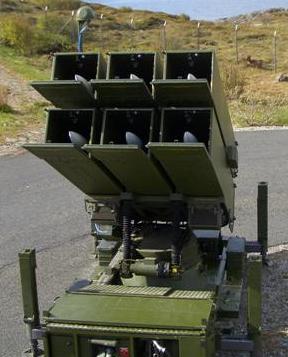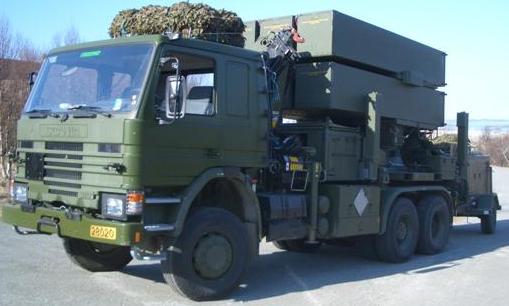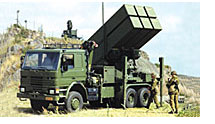NASAMS is a distributed and networked medium range air-defence system. NASAMS was the first surface-based application for the AIM-120 AMRAAM, and the first surface-to-air missile system in the western world with active radar guidance.
 NASAMS launcher.
NASAMS launcher.Development
The Norwegian company Kongsberg Defence & Aerospace teamed up with Raytheon and initiated the NASAMS programme as a cooperative effort for the Royal Norwegian Air Force. The state-of-the-art network-centric air defence system NASAMS was declared fully operational capable in 1998, but had an initial operational capability as early as in 1994/95.
Until the late 1990s the RNoAF ground based air defence solution, also known as the Norwegian Solution (NORSOL) consisted of three different weapon systems; the 40mm BOFORS "L70" gun - controlled by the Oerlikon Contraves monopulse doppler tracking radar "FCS2000" - the laser beam riding RBS 70 MANPADS system and the NASAMS. All three systems were integrated through the ARCS via field wires and radio. The ARCS maintained connection to higher echelons and ensured protection of friendly aircraft while preventing over- and underkill for all subordinate weapon systems. NASAMS capabilities are enhanced by the system's networked and distributed nature. A version of NASAMS has been exported to Spain.
The RNoAF together with KDA is currently running a mid-life update of the NASAMS, called NASAMS II, and the upgraded version will be handed over to RNoAF in mid 2006. Full operational capability (FOC) is expected in 2007.
 NASAMS launcher on Scania 113H truck.
NASAMS launcher on Scania 113H truck.Description
The system integrates US-built AN/TPQ-36A 3D radars and AIM-120 AMRAAM missiles with an indigenously developed BMC4I system called FDC, short for Fire Distribution Center. The FDC connected to a TPQ-36A radar forms an "Acquisition Radar and Control System" (ARCS). NASAMS is operated by the Royal Norwegian Air Force.
White House defence
In 2006 the Norwegian magazine Økonomisk Rapport (Economic Report) revealed that several NASAMS were used to guard air space over Washington, D.C. during the 2005 presidential inauguration. According to the report, the same NASAMS units has since been used to protect air space around the White House. The magazine had gotten access to the deal which mentioned specifically that the equipment be used for protection of the President in Washington. Director Tore Sannes of Kongsberg Defence & Aerospace refused to comment, other than acknowledging that they had made a weapon systems deal with US military contractor Raytheon and the USAF.
Operation
Norwegian NASAMS batteries each consist of:

- three or four Fire Distribution Centres;
- three or four Raytheon AN/TPQ-36A surveillance, acquisition and tracking radars;
- nine truck-mounted missile launchers (with six missiles each)
- three or four vehicle-mounted passive infrared tracking cameras for visual target identification and raid size assessment.
In this configuration, NASAMS is capable of engaging up to 54 different targets by firing 54 individually-targeted missiles within a matter of seconds. A capability unmatched by any comparable system.
Using a combat net radio, the launchers can be located up to 25km from the FDC, expanding the defended footprint. NASAMS is fully mobile and can be ready-to-fire at a new location 15 minutes after the wheels stop turning.
The Norwegian NASAMS systems will likely receive an upgrade in the near future, including:
- upgrading the radar to the standard of Raytheon's state-of-the-art AN/MPQ-64 Sentinel 3D radar
- inserting the latest commercial-off-the-shelf computer technology to the FDC
- integrating the new Kongsberg Multi-Role Radio
- integration with Kongsberg's Ground Based Air Defence Operations Centre (GBADOC).
Sources: Wikipedia.org & Kongsberg.com
